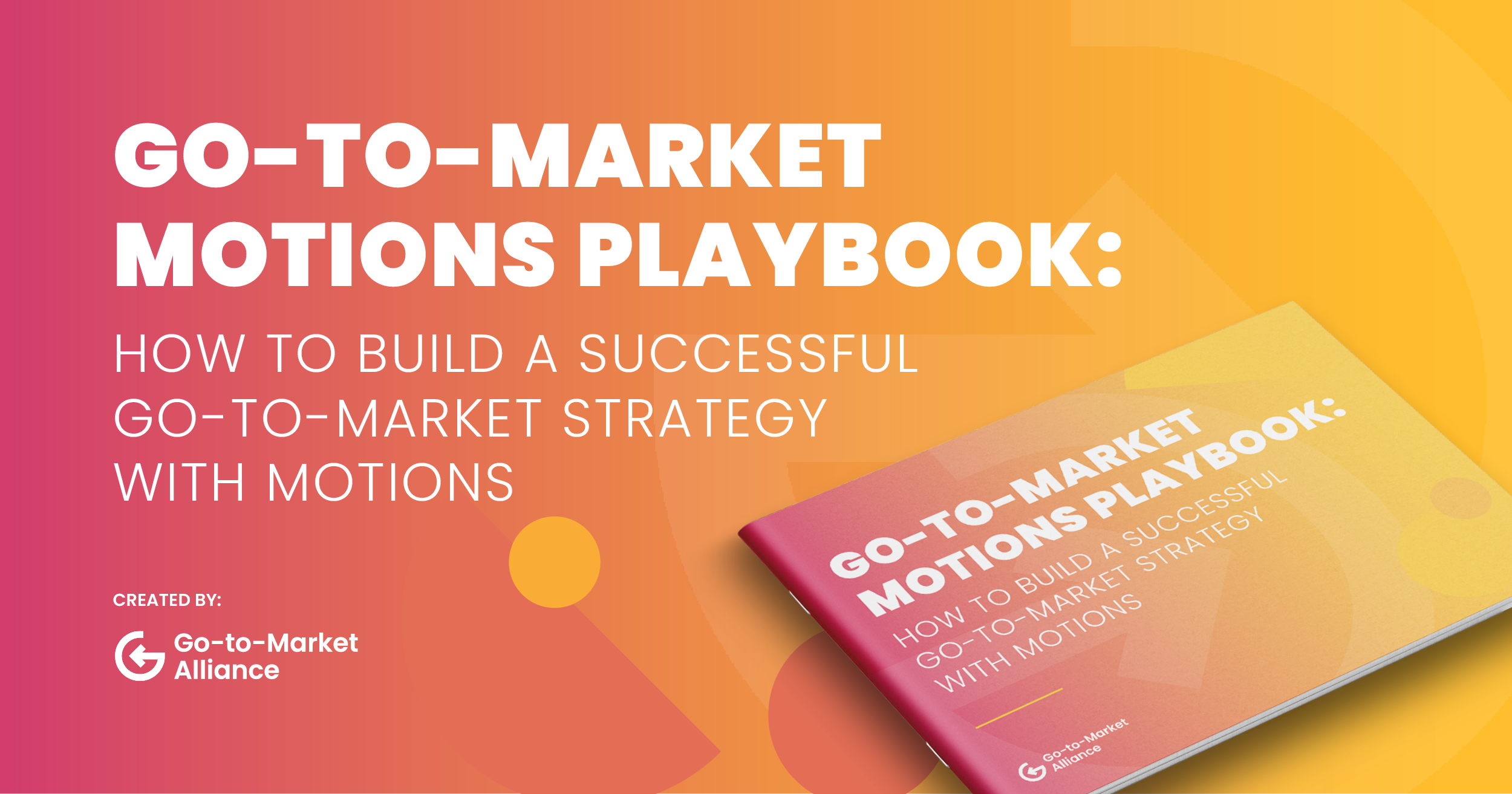Learn the ins and outs of Go-to-Market strategy with the help of this featured article from our sister community, Go-to-Market Alliance!
What is Go-to-Market?
Go-to-Market is the strategy that takes you from the first spark of an idea, to a successful product or feature launch and beyond, to the market success of your product. Put simply, it’s the process of launching a new product.
But rather than approaching each launch as a new process, a Go-to-Market strategy is a defined process you’ve tailored for your business and can use time and time again. It’s a broad strategy that touches pretty much every aspect and function of your business.
A defined Go-to-Market strategy is repeatable, scalable and will help you launch more effectively. In this article, you’ll learn about the core teams involved, the stages of Go-to-Market and agile strategies you can adopt. And don’t forget to follow the links for more detail on the topics most relevant to you.
Go-to-Market teams
Every company functions differently, and this list could be a lot longer, but these are the core teams you need for a Go-to-Market strategy to function.
Product
Product teams combine market knowledge, business strategy and technical expertise to design and build products that solve customer problems and, ideally, plug a gap in the market. Product design is not a function that can happen in isolation, and bringing in a marketing lens early on in the process is hugely beneficial for strategic product design. For this reason, the product team tends to work closely with product marketers when it comes to Go-to-Market strategy.

Product marketing
Product marketing is marketing with a product lens. Instead of building a product and then looking to see if it has a place in the market, product marketing prioritizes building products with market research, customer pain points and opportunities for product market fit at the forefront of your design process. If you don’t have a designated product marketing team, getting marketing input on the product stage is still incredibly beneficial.
Sitting within the marketing team, product marketers are often viewed as bridging the gap between internal and external stakeholders. Product marketers can bring customer and market knowledge to the ideation stage of your Go-to-Market process, as well as being arguably the best placed to carry out positioning, messaging, pricing strategy and the product launch itself.
Product marketers will lead all marketing activities before, during and after launch, but any PMM worth their salt will also have product insights and be instrumental in crafting your value proposition and effectively communicating with and educating teams further down the Go-to-Market timeline.
Read more about:
Sales enablement
An effective Go-to-Market strategy depends on frontline teams being properly onboarded with product knowledge, buyer personas and customer pain points. If you want every step in your customer’s journey to be seamless, then sales reps need to know what's happened before they’ve got involved.
Sales enablement teams make sure that your sales reps are up to scratch when it comes to all of this information and have everything they need to convert prospects into buyers.
The leading responsibilities of sales enablement teams are onboarding reps, sales content creation, revenue enablement and sales KOs.
Read more about:
Customer success
Customer success is too often overlooked, given they’re the most important team in your Go-to-Market strategy after a prospect becomes a buyer. It’s easy to think that once someone buys your product it’s job done, but that couldn’t be further from the truth. Customer acquisition is really expensive, whereas retention is cheap. Once you’ve a customer in, you want to keep them for as long as possible.
Customer success ensures that a customer’s lifetime value (ie how long they’re a customer of your brand) is as long as possible. They achieve this by onboarding customers to get the most value out of your product and preventing customer churn.
Read more about:
Go-to-Market stages
Ideation
The ideation stage is when the product is developed, and the product roadmap and sales pipeline are planned out. It’s important to make sure that those leading on the Go-to-Market strategy have a working knowledge of the product at this stage, so they can think tactically about its value and how to achieve product market fit.
Getting the product roadmap nailed down at this stage allows you to set expectations for the launch and communicate to stakeholders when they will be involved in the strategy. At this stage you’ll also need to decide:
- Who your total addressable market are
- Your buyer personas
- The distribution model for your product
- Your pricing strategy
This will influence the work you do at the build stage.
Build
At this stage, your Go-to-Market team should be building out the assets you’ll need for your launch. This doesn’t just mean the launch day itself, but everything leading up to it. The strategies most associated with this stage are positioning and messaging.
Positioning is literally how you position your product in the market. You’ll develop an internal positioning statement, which is used to communicate to your stakeholders the value of your product, the pain points it resolves, the type of customers (i.e. personas) you’ll be targeting and what sets this product apart from the competition.
Messaging is guided by your positioning. This is the external tool that conveys everything you’ve defined in your positioning statement to your prospective customers. Messaging encompasses all of your marketing assets, such as social media, email campaigns, webinars and so on.
This is also the time to be educating your frontline teams and making sure you have everything ready for launch.

Soft launch
An important but often overlooked stage, this is where you carry out testing of your product and launch assets to see if they’re hitting the mark. You should test internally first, then externally with focus groups or a selection of existing customers.
If you find at this stage that your messaging isn’t resonating, or users are struggling to find value in your product, you have the opportunity to make adjustments before you commit to an expensive full launch.
Learn more about testing here:

Go-to-Market launch
At this stage, all of your assets should be ready to go. Landing pages should be built, email campaigns set up. Everything is ready to go live at the flick of a switch.
Your launch size will vary depending on the type and scale of your product. If it's a big flagship launch, you’ll want all hands on deck and a big splashy launch that grabs attention. For a smaller launch, you won’t want to expend that many resources.

But whatever you do, make sure it’s consistent with your messaging and all launch assets go live at the same time. You don’t want to announce a product to customers, only for them to find it doesn’t yet exist on your website.
Make sure you have everything ready for launch with our product launch checklist:

Post-launch
There ain’t no rest for the wicked. Meaning, in this case, just cause the launch is over doesn’t mean your work is done. To make sure a product really finds its place in the market and stays there, you need to carry out post-launch activities.
This will look different for different companies, but for a large launch, you’re looking at at least six more months of marketing activities.
And of course, your customer success and sales strategies will be in full swing at this point. These are essential to keep new customers coming in and to convert casual buyers into advocates of your brand. The customer journey doesn’t end when a purchase is made, it’s actually only just beginning. Don’t overlook that.
Learn more about post-launch activities here:

Go-to-Market strategy
Cross-functional alignment
You’ve probably picked up on the fact that a lot of different teams are involved in GTM. In the modern business world, increasingly made up of hybrid and remote teams, it’s harder than ever to make sure your teams are properly aligned.
This doesn’t just mean working together, although it’s a good place to start. Cross-functional alignment is about ensuring that all your teams understand the overall business objectives, have access to the same information and know what the responsibilities of their fellow teams are.
Misaligned work results in missed deadlines and wasted time, which you just don’t have room for in a successful business.
Get everyone on the same page and speaking the same language, make sure your teams are transparent about their responsibilities and workloads AND remove any barriers to communication between teams that you can.
Beyond this, it’s important to set a business cadence for meetings early on in your Go-to-Market strategy, to make sure your teams come together often enough to keep abreast of each other’s progress, but not so often that you’re wasting time.
Build your own cross-functional Go-to-Market strategy with Go-to-Market Alliance's free playbook:

Go-to-Market motions
Every Go-to-Market strategy has a driving force behind it; that driver is better known as a motion. The four main Go-to-Market motions are:
- Product-led
- Sales-led
- Community-led
- Content-led
Whichever you choose for your GTM strategy, it should support your overall business objectives. Your motion will guide all your Go-to-Market activities, how you grow your customer base and your business model.
To find out more about the Go-to-Market motions and how to choose the best one for your business and product, download your free copy of the playbook here:

Quick Go-to-Market index
When you’re researching Go-to-Market strategies, there are some key terms you’ll come across time and time again. You can find definitions of those terms here.
- Buyer personas
Buyer personas are a tool to help you better understand your prospective customers. You identify the types of customers your product will appeal to, then research them and fill out a persona so you and your GTM teams can know how to sell to that customer type.
- Product roadmaps
Product roadmaps are a single source of truth, outlining the timeline and vision for a product. These are essential tools for your stakeholders to understand what their product strategy is working towards, what’s needed of them and what the priorities and challenges of their peers are.
Learn more about product roadmaps here:

- Sales funnel
The sales funnel allows us to understand the journey buyers go on. As with a real funnel, prospective customers are taken on a journey, ideally from their first introduction to your brand to being loyal advocates of your business to others. A Go-to-Market strategy is designed to try and move as much of your TAM (total addressable market) down the funnel as possible.
- Segmentation
Many customers make up your TAM, and they’ll have different pain points and priorities. By segmenting your customers you can tactically apply the right marketing strategies to the right segments. Common segments include age, geography, gender, and so on.
Find out how to use segmentation to your advantage here:

- Pain points
Pain points are the problems a customer has. Your job is to deliver products that resolve these pain points and to design a GTM strategy that effectively communicates how the product will do so.
Learn more about pain points here. 👇

- Product market fit
Product market fit refers to having successfully found a gap in the market and plugged it with a product that consumers want. It’s hard to measure, and unfortunately, there’s no magic wand you can wave to achieve it, but if you have product market fit your product will be selling, you’ll have organic growth and your revenue will be going up.

- Total addressable market
More commonly known as TAM, this refers to the total number of potential market opportunities for your product. Not everyone in the world will be interested in your product, it’s important to work out what your market opportunities are and focus on them, to make the best use of your resources.

Join 9,000+ of your sales enablement peers in SEC's Slack group! Idea-share, network, and ask questions in the community.




